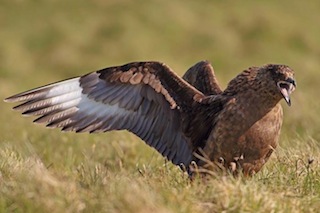 Great Skuas breed far to the north, but keep an eye out for them at sea as they migrate south in the late summer.
Great Skuas breed far to the north, but keep an eye out for them at sea as they migrate south in the late summer.
Photo (of bird at breeding grounds on Shetland): Amanda Scott
Scientific name: Catharacta skua (very recently moved from Stercorarius genus)
Other common names: Bonxie (in Shetland)
Conservation status: UK Birds of Conservation Concern, Amber; IUCN Red List, Least Concern
What to look for:
- Colouring and appearance: A stocky Herring Gull-sized bird, dark grey-brown colouring, strongly streaked; in summer, yellow-brown and streaked on neck. Large white flashes on wings are distinctive in flight. Often soars when flying.
- Size: 50 to 58 cm in length; wingspan of 125 to 140 cm.
- Where: In the UK, breeds in Scotland by the coast on rocky islands and clifftops. Elsewhere may be seen along the coast as it migrates to and from its wintering grounds.
- Call: Only makes its guttural calls on its breeding grounds.
- Similar species: Other Skuas, such as the Arctic Skua. The Great Skua’s white wing flashes are a distinguishing feature.
 If you have ever been dive-bombed by a Great Skua, feeling the rush of its wings within inches of your head, you will know what an unsettling experience it can be. This is a bird that shows no fear, and that is fiercely protective of its nest on its breeding grounds. The Great Skua is an aggressive scavenger: it will tangle with gulls and gannets if it thinks it can steal a meal, pinches eggs, and catches and eats small seabirds as well as small mammals and fish
If you have ever been dive-bombed by a Great Skua, feeling the rush of its wings within inches of your head, you will know what an unsettling experience it can be. This is a bird that shows no fear, and that is fiercely protective of its nest on its breeding grounds. The Great Skua is an aggressive scavenger: it will tangle with gulls and gannets if it thinks it can steal a meal, pinches eggs, and catches and eats small seabirds as well as small mammals and fish
You won’t be swooped by a Great Skua in Cornwall: in the UK it only breeds in Scotland (including Orkney and Shetland), on moors close to the clifftops or on offshore islands, laying its eggs in nests lined with grass on the ground.
Sightings on land in other parts of the UK are rare, but birds can be spotted flying out at sea as they migrate in spring from their wintering areas out at sea around the coastline of Spain and Africa. In late summer they can again be spotted as they migrate back south again. They often stay close to seabird colonies, where scavenging opportunities are good.
The Great Skua is listed as an Amber species in the ‘UK Birds of Conservation Concern’. This is due to the highly localised nature of its breeding grounds, and because of the importance of the Scottish sites, which represent some 60% of global breeding sites. It has however been increasing in population levels since the start of the twentieth century, and at the same time has extended its breeding range into the Barents Sea and southwards onto Scotland’s western isles.
Did you know…?
…The Shetland name, Bonxie, could be derived from the Old Norse word bunki, meaning ‘dumpy’, a reference presumably to its stocky build.
…Great Skuas might have a reputation for being ‘rough and tough’, but they are also intelligent birds, able to learn and pass on new feeding behaviours. One well-known recent example is from St. Kilda, where they have taken to preying on Leach’s Storm Petrels at night (storm petrels only return to their breeding colonies by night), an unusual nocturnal feeding pattern.
More information and references:
Svensson, L., Mullarney, K., Zetterstrom, D.,1986. Collins Bird Guide, second edition (translated by Christie, D., Svensson, L.). HarperCollins, London.
Published: August 2014
Author: Amanda Scott
Photos: Amanda Scott (Great Skua (Bonxie) displaying on Shetland)
